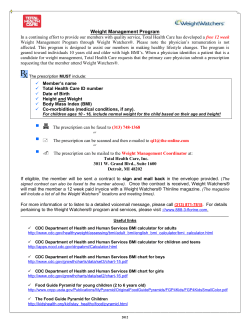
Ideal Cardiovascular Health and Abdominal Obesity in a Biracial Sample... D.M. Harrington & P.T. Katzmarzyk BACKGROUND:
Ideal Cardiovascular Health and Abdominal Obesity in a Biracial Sample of Children D.M. Harrington & P.T. Katzmarzyk Pennington Biomedical Research Center, Louisiana State University System, Baton Rouge, LA BACKGROUND: Ideal Cardiovascular (CV) Health is the American Heart Association (AHA) definition of CV health and is made up of 7 metrics. One of the AHA 2020 Impact Goals is to improve the CV health of all Americans by 20% (LloydJones et al., 2010). The individual metrics are well supported in the literature but the degree to which Ideal CV Health is related to adiposity in specific body depots in children is unknown. Aim: Table 1. AHA Ideal Cardiovascular Health and it’s measurement and prevalence in the present study AHA Criteria Current Smoking Sample: The sample consisted of 363 children from age 5 to 18 years (94 White males, 78 African American males, 80 White females, and 111 African American females) who did not report any past cardiovascular related diagnoses. Mean BMI percentile for the same was 73rd (SD: 28). MRI: Abdominal VAT and SAT masses were measured by MRI (GE Signa Excite 3.0Tesla, GE Medical Systems, Milwaukee, WI). A series of scans from the highest point of the liver to the bottom pole of the right kidney were acquired. Images were analyzed using the Analyze® software package (CNSoftware, Rochester, MN). DXA: A whole body dual energy X-ray absorptiometry (DXA) scanner (Hologic QDR 4500, Bedford, MA) was used to quantify participant’s TBF mass. Scans were analyzed with QDR for Windows V.11.2. Ideal CV Health: The 7 Ideal Cardiovascular Health metrics, and how they was assessed herein are reported in Table 1. Statistical Analysis: VAT, SAT and TBF were regressed against age for each sex by race group. These sex- and race-specific residuals were divided into quartiles to represent age-adjusted adiposity levels. The highest quartile represented the “at-risk” group. Logistic regression, controlling for age and race, was used to calculate odds ratios (OR). ≥ 5 Ideal CV Health criteria was used as the reference. Each OR was converted to a relative risk as per Zhang & Yu (1998). Never tried; never smoked a whole cigarette Physical Activity ≥ 60 mins MVPA every day Healthy Diet Score The aim was to investigate how Ideal CV Health relates to abdominal visceral (VAT) and subcutaneous (SAT) adipose tissue and total body fat (TBF), with and without including BMI as a criterion. METHODS: AHA Definition Body Mass Index Defined in the Source Analysis Answered no to ‘Do you Self-report smoke or use tobacco’ questionnaire‡ 4 - 5 Components 1. Fruits and Vegetables, 2. Fish, 3. Fiber rich whole grains, 4. Sweets and sugar sweetened beverages, 5. Sodium 7 days active ≥ 60mins/day 4 - 5 Components 1. Fruit and Vegetables, 2. Fish, 3. Brown bread, 4. Soft drinks, sweets, cakes 5. N/A Self-report questionnaire‡ Self-report Food Frequency questionnaire‡ < 85th percentile <85th percentile Height and weight in duplicate Measured Fasting Measured sitting quietly, in duplicate Measured Fasting Total < 170 mg/dL (untreated) Cholesterol Blood pressure < 90th percentile (untreated) Fasting Plasma < 100 mg/dL (untreated) Glucose ‡ With parental assistance if necessary < 170 mg/dL Both SBP and DBP < 90th percentile < 100 mg/dL Prevalence of Ideal 99% VAT SAT TBF RR 15.3 (8.6-21.4) RR (BMI Excluded) 1.6 (0.8-2.7) 4 10.1 (4.9-16.8) 1.1 (0.4-2.0) ≥5 1.0 1.0 ≤3 18.7 (9.7-27.0) 2.0 (0.8-3.4) 1.4 (0.6-2.8) 4 13.1 (5.9-22.2) ≥5 1.0 1.0 ≤3 18.4 (9.5-26.8) 2.0 (0.8-3.4) 4 12.9 (5.8-22.0) 1.4 (0.5-2.7) ≥5 1.0 1.0 deirdre.harrington@pbrc.edu A total of 24.2% (88/363) of the sample had ≤ 3, 36.4% (132/363) had 4, and 39.4% (143/363) had ≥ 5 Ideal Health criteria. Prevalence of the Ideal level of each metric can be found in Table 1. 9% 2% 53% 63% 93% 96% Table 2 Relative risks (RR) for the prediction of the upper quartile of adiposity measures from the number of Ideal Health criteria Number of Ideal Health Criteria ≤3 RESULTS : White participants possessed more metrics (χ2=17.7; p=0.001) than African Americans but there were no sex differences evident (χ2 =1.0; p= 0.91). Those with fewer Ideal Health metrics had a significantly greater risk of having high abdominal VAT, SAT and TBF (Table 2). Once BMI was removed as a metric, due to its high correlation with adiposity, the RR estimates were substantially reduced. CONCLUSIONS: A lower number of Ideal criteria was related to higher abdominal and total adiposity. While it appears that a large part of the association can be explained by BMI, a substantial increase in risk exists for those with ≤ 3 Ideal criteria. These data lend support to the American Heart Association’s Ideal CV Health. Individuals should be supported in increasing the number of Ideal criteria they possess. ACKNOWLEDGEMENT: The authors wish to thank Dr. Alok Gupta, Dr. Stephanie Broyles and Dr. Amanda Staiano. This work was supported by grant # NIH-NIDDK-1RC1DK086881-01 and by a Nutrition Obesity Research Center (NIH2P30DK072476) grant from the National Institutes of Health. clinicaltrials.gov registration# NCT01595100 REFERENCES: • Lloyd-Jones, et al. Circulation. 2010: 121(4); 586-613 • Zhang & Yu. JAMA.1998:280(19); 1690-91
© Copyright 2025





















